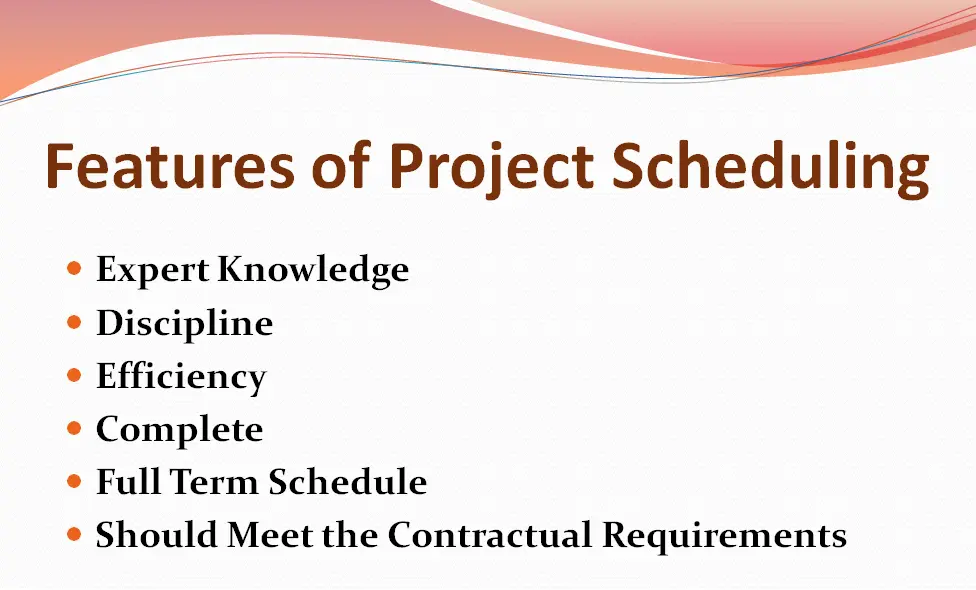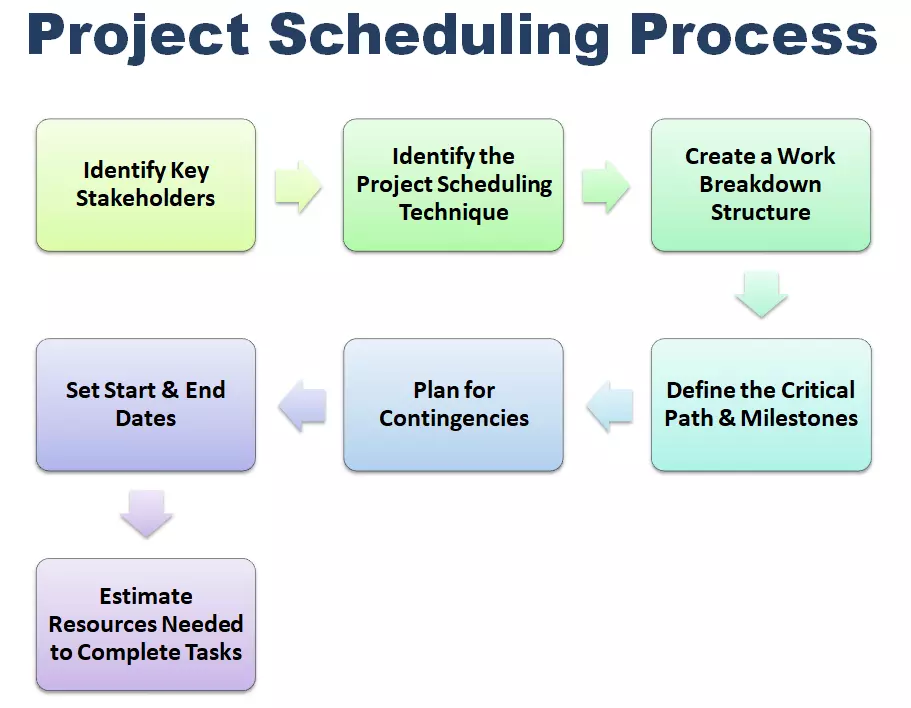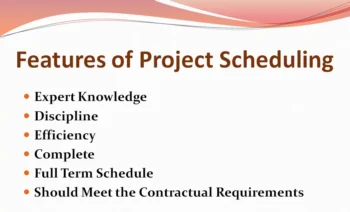Table of Contents:-
- What is Project Scheduling?
- Meaning of Project Scheduling
- Features of Project Scheduling
- Types of Project Scheduling
- Types of Project Constraints in Scheduling
- Advantages of Project Scheduling
- Disadvantages of Project Scheduling
- Benefits of Project Scheduling
- Project Scheduling Techniques
- Steps in the Project Scheduling Process
What is Project Scheduling?
Project scheduling is a critical management task as it dictates the time frames in which the project will be completed, the budgets/costs in terms of resource requirements, and the sequence of tasks to be completed. Project scheduling is defined as the process of determining when project activities will take place depending on defined durations and precedent activities. Schedule constraints specify when an activity should start or end, based on predecessors, duration, external predecessor relationships, target dates, resource availability, or other time constraints.
Project scheduling is a complex and iterative task that typically involves:
- To assign resources to project tasks.
- Ensuring completion dates align with the availability of the necessary resources is essential to complete all tasks within the given timeframe.
- To identify dependencies between tasks and schedule them in the correct sequence.
- To Identify realistic start and end points (elapsed time) to accommodate the number of man-days of work for each given task.
- Critical path analysis to identify those tasks critical to the success and timely completion of the project.
Meaning of Project Scheduling
The project schedule is the tool that communicates the required tasks, specifies which resources within the organization will perform the work, and outlines the timeframes for the completion of each task. It should comprehensively reflect all the work associated with ensuring the project’s timely delivery. Without a comprehensive schedule, the project manager cannot effectively communicate the entire effort in terms of cost and resources needed to deliver the project. Project team members associated with the team can view and update the project schedule, ensuring that everyone stays well-informed about the overall project status.
Project scheduling involves the techniques used to manage the activities required during the development of a project.
Scheduling is carried out in advance of the project commencing and involves the following:
1) Identifying the tasks that require completion;
2) Estimating how long they will take;
3) Allocating resources (mainly personnel), and
4) Scheduling when the tasks will occur.
Features of Project Scheduling
The following are the features of project scheduling:

1) Expert Knowledge
Project scheduling does not only allow the whole team to capture the vision of the project, but it also helps workers understand company policies. The expertise that each worker develops benefits the company as a whole in the long run as workers become more efficient at executing their tasks.
2) Discipline
Designing a schedule for a project requires the project major to identify risks, understand everything needed to meet the set goals and finish the project within the scheduled time. If the project involves building a community school, for instance, the project manager needs to determine a budget first, then schedule time to hire the required manpower, and then the rest will follow. One of the major features of project scheduling, therefore, is that it instils the discipline required to accomplish a mission in time.
3) Efficiency
When tasks are finished within the scheduled time, the probability of finishing a project in time is higher. Efficiency is cost-effective. If you have to rent a utility vehicle, for example, or hire a team of workers, the faster employees complete their project the less money the resources will cost. It is only through scheduling that the project manager will be able to tell whether the resources assigned are adequate to do the job within the timetable.
4) Complete
A project schedule must be in complete form. It comprises the entire scope of project, meaning that no elements are left out. All change orders should be incorporated into the schedule. So that it will lead to the success of a project.
5) Full Term Schedule
The schedule begins on the notice to proceed date and is completed according to the contractual dates.
6) Should Meet the Contractual Requirements
The schedule should comply with the contract milestones. The schedule should also comply with the level of detail required by the contract (if applicable).
Types of Project Scheduling
There are three types of project scheduling as explained below:
1) Master Scheduling: A master schedule outlines the quantity of various products to be produced for the entire year, providing monthly production units for different products. The master schedule is established based on sales forecasts, marking the initial phase of production planning.
2) Parts Scheduling: The parts schedule outlines the quantity of different parts to be produced for a specific product. The schedule is prepared every month, providing production details for each week. The parts schedule is created based on the master schedule.
3) Machine Loading Schedule: Machine loading schedule in the process of allocating workload for various machines. It is a timetable for the working of various machines. This schedule is prepared for one week. It gives details of machine loading for every day of the week. This scheduling is prepared based on the parts schedule.
Types of Project Constraints in Scheduling
Two project constraints need to be considered in scheduling:
Time Constrained
Every project is invariably time-bound. The schedules clearly define the time limits. Every project has a specified start date and completion date. This time limit is either self-imposed or it is specified by the claims The life span of a project can run from a few hours to a few years. A project concludes either when it successfully delivers the product and/or service according to the client’s requirements or when it is determined that the project can no longer fulfill the client’s specifications for the final product and/or service.
Sometimes, a given deadline for the project completion time of a project may be too tight order to be realised with the resources initially provided. In this case, additional resources have temporarily to be allocated in certain periods resulting in additional costs depending on the respective resource type. The Time-Constrained Project Scheduling Problem (TCPSP) consists of determining a schedule such that the project is completed on time and the total additional costs are minimised.
Resource Constrained
The physical and human resources are granted to and used by the project to meet the project’s performance objectives. The amount of resources that can be allocated depends on the timing of the allocation as well as on the total supply of resources available for the same limited resource. The amount of the resource(s) required (estimated) for each time unit during activity duration. The required resource amount can be constant or variable over the activity’s duration.
The absence or shortage of resources can significantly impact technical constraints. While a project network planner might assume sufficient resources and depict activities happening concurrently, such parallel activities can lead to resource conflicts. This resource constraint necessitates that activities be executed in sequence or series.
The interrelationship between Time Constrained and Resource Constrained
The interrelationships and interactions among time and resource constraints can be intricate, even for small project networks. A proactive examination of these interactions before the project commences often reveals unforeseen issues. Project managers who neglect to consider resource availability in moderately complex projects typically discover the problem when it’s too late to rectify. A shortage of resources can significantly impact project dependency relationships, completion dates, and project costs. Project managers must meticulously schedule resources to ensure their availability in the right quantities and at the right time. Fortunately, there are computer software programs that can identify resource problems during the early project planning phase, allowing for corrective changes. These programs only require information on activity resource needs and availability to schedule resources.
When the available number of people and/or equipment is insufficient to meet peak demand requirements, and obtaining more is impossible, the project manager encounters a resource-constrained problem. The challenge lies in prioritizing and allocating resources to minimize project delays without surpassing the resource limit or altering the technical network relationships.
The resource scheduling problem is a substantial combinatorial one. Even a modest-sized project network with only a few resource types might yield several thousand feasible solutions. Some researchers have showcased optimal mathematical solutions to the resource allocation problem, but these have been limited to small networks and very few resource types. The extensive data requirements for more significant problems render pure mathematical solutions (e.g., linear programming) impractical. An alternative approach to the problem involves the use of heuristics (rules of thumb) to address large combinatorial problems.
Since each project is unique, it is prudent to test multiple sets of heuristics on a network to ascertain the priority allocation rules that minimize project delays.
Schedule activities using the following heuristic priority rules in the given order:
1) Minimum slack,
2) Smallest duration, and
3) Lowest activity identification number.
Advantages of Project Scheduling
The following are the advantages of project scheduling:
1) Leads to Motivation: A written plan and schedule, it’s similar to maintaining an ongoing to-do list for business. Completing and checking off the items on the plan will help motivate the employees to accomplish the project goals. Each item which is completed represents a success for the business. With the accompanying schedule project manager can also monitor and celebrate achieving that goal on time or earlier than scheduled.
2) Streamlines Communication: While planning and scheduling the projects, it also helps improve communication among the team. All members have the same guidelines to follow when working so they are all on the same status. If any of the employees are confused about the process or timeline, they can simply refer to the schedule. Since everything is scheduled, there is little room for disagreements or confusion.
3) Keeps Costs Under Control: A well-developed project plan and schedule also allow for the management of project costs more efficiently. When developing the plan, the project manager can list the estimated investment required to complete each step and then calculate the total cost of the project. So helps in maintaining the cost of the project in the best possible way.
Disadvantages of Project Scheduling
The following are the disadvantages of project scheduling:
1) Deadlines Add Pressure: While a deadline can enhance focus, it can also introduce pressure. If the deadline is too tight or unforeseen issues arise, it can impose additional stress on the team. Working under stress increases the potential for errors, as the team may rush to meet the deadline. In such situations, team members might overlook crucial details or, worse, cut corners to finish on time, leading to the failure of the project.
2) A Tight Schedule can Lead to Conflict: When the team is under the pressure of a tight deadline, stress levels are elevated. Elevated stress levels can lead to conflicts. A team with members in conflict with each other will be ineffective.
Benefits of Project Scheduling
Let’s quickly explore some benefits of project scheduling to understand the role of project scheduling in management.
1. Detailed Overview: A schedule provides a detailed overview of what needs to be done and when.
2. Real-time Monitoring and Control: It allows you to monitor and control the project schedule in real-time.
3. Single Source of Truth: It serves as a single source of truth for all your project tasks, subtasks, events, and milestones.
4. Task Accountability: It helps establish task accountability with clear-cut task responsibilities.
5. Task Dependencies and Priorities: You can track which tasks are interdependent and which are of high priority.
6. Team Performance Tracking: It allows you to keep track of team performance and make adjustments if needed.
7. Risk Identification: It helps identify gaps and potential risks in a timely manner.
8. Project Progress: It lets you stay up-to-date with project progress.
9. Workload Management: You can manage workload across different tasks and work items.
10. Adaptability to Changes: You can adjust schedules easily when requirements evolve.
11. Enhanced Collaboration: It enables better team collaboration.
Without project scheduling, tracking of project’s status can be time-consuming and challenging. Using a project schedule, can help to monitor key metrics and steer a project in the right direction for sure-shot success.
Project Scheduling Techniques
Here are the most commonly used project scheduling techniques that you can choose from.
Gantt Charts
A Gantt chart is a bar chart illustrating tasks and timelines. It displays tasks, subtasks, and events on the left side, while the right side shows bars representing start and end dates. Gantt charts provide a visual overview, allowing clear identification of task overlaps and resource optimization.
Task Lists
Creating a task list is a simple scheduling method. Tasks are listed chronologically with start and end dates, and subtasks can be listed under each task. While suitable for small projects, it may lack visual representation for multiple dependencies and flexibility for adjustments.
Project Calendars
Project calendars help visualize the project schedule at a glance. Organize tasks, subtasks, and events across the calendar for easy comprehension of the project timeline. It facilitates accurate scheduling of future tasks, preventing overlaps, and allows personal event scheduling without conflicting with work.
Critical Path Method
The Critical Path Method identifies crucial tasks in the project schedule, representing the longest sequence essential for project completion. Tasks on the critical path are interdependent and must adhere to a fixed schedule.
Resource Leveling
Resource leveling involves strategic allocation of resources to tasks, preventing underutilization or overuse. This technique avoids scheduling conflicts, ensures optimal resource utilization, and contributes to timely project completion.
These project scheduling techniques offer diverse options based on project size, complexity, and specific requirements.
Steps in the Project Scheduling Process
Steps in the Project Scheduling Process are as follows:
- Identify Key Stakeholders
- Identify the Project Scheduling Technique
- Create a Work Breakdown Structure
- Define the Critical Path & Milestones
- Plan for Contingencies
- Set Start & End Dates
- Estimate Resources Needed to Complete Tasks

Identify Key Stakeholders
Initiate the project by identifying key stakeholders actively involved in the development process. Stakeholders contribute to creating a project outline aligned with expectations and play a vital role in achieving desired outcomes. Ensure their optimal involvement for project success.
Identify the Project Scheduling Technique
Choose a project scheduling technique based on the project’s nature. For example, opt for the Critical Path Method for timely milestones or the Gantt technique for comparing the actual schedule with a baseline. Tailor the choice to your project’s specific requirements.
Create a Work Breakdown Structure
Break down the project into manageable pieces by defining deliverables and establishing step-by-step tasks. Develop task sequences, identify dependencies, and set a clear path for execution. Define interdependent tasks, allowing effective delegation and simultaneous progress tracking across various tasks.
Define the Critical Path & Milestones
Clearly define the critical path in the project timeline, emphasizing phases essential for completion. Establish milestones as vital checkpoints in the project life cycle. For instance, in a construction project, setting and drying concrete represent critical milestones. Milestones facilitate progress tracking and overall project performance assessment.
Plan for Contingencies
Anticipate uncertainties and plan for contingencies throughout the project. Develop a detailed risk management plan to reduce potential risks. Factor in risks such as team members quitting or market evolution, ensuring preparedness for unexpected challenges.
Set Start & End Dates
Complete your schedule by setting timelines for each task, subtask, event, and activity. Reference lessons learned from earlier projects to create accurate estimates. Consider team leaves and holidays to refine estimates for time durations, leading to a more realistic project timeline.
Estimate Resources Needed to Complete Tasks
Estimate the resources required for various project tasks and subtasks, including manpower, equipment, budget, and tools. Ensure accurate estimates without overestimating or underestimating resources, avoiding resource idle time or burnout. Reference lessons learned for creating precise resource estimates.
Following these steps systematically allows for the creation of a comprehensive project schedule, facilitating successful project execution within defined timelines.
